
The vivo X70 focuses on the same aspects as its predecessor – imaging prowess – which is why ZEISS lenses are still on the device alongside with several new improvements like ZEISS T* Coating, better Night Performance and additional Portrait modes among others. It also uses a the new Dimensity 1200 platform instead of the X60’s Snapdragon 870 5G.
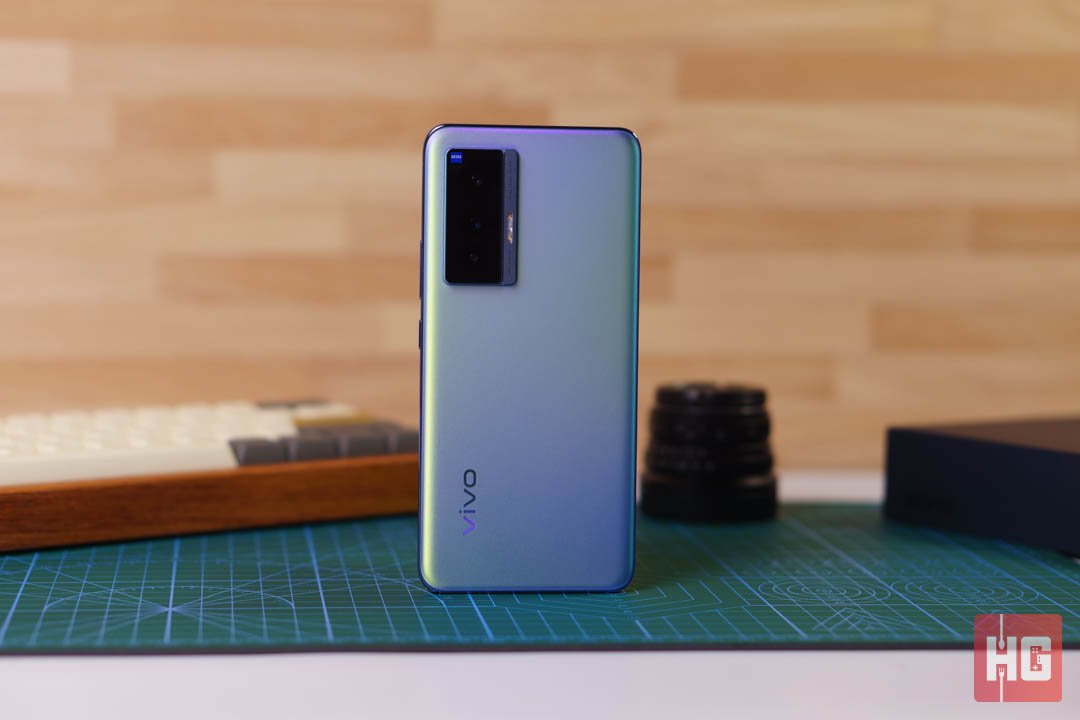
| Chipset | MediaTek Dimensity 1200 |
| Screen | 6.56-inch AMOLED, 2408 x 1080, 120Hz, HDR10+ |
| RAM | 12GB + 4GB |
| OS | Android 11, FunTouch OS 11.1 |
| Rear Camera | 40MP f/1.8 IMX-776V Main, 12MP f/2.2 Ultrawide, 12MP f/2.2 Telephoto; ZEISS T* Coating, Dual-Tone Flash, Pixel Shift |
| Front Camera | 32MP f/2.45 |
| Storage | 256GB UFS 3.1 |
| Network | 5G, 4G LTE |
| Connectivity | Dual-Band WiFi 802.11ax, Bluetooth 5.2, NFC, USB Type-C |
| Battery | 4,400mAh, 44W Fast Charging |
| Others | In-Display Fingerprint Scanner |
| Colors | Cosmic Black, Aurora Dawn, White |

The vivo X70 is encased in a flat blue box that looks more deluxe than your average smartphone packaging. Encased inside is the X70 itself and a fairly complete set of accessories: a USB Type-C cable, a 44W wall charger, Type-C headphones, a silicon case, a SIM ejector pin, and its documentation.

vivo does not detract from their traditional design language with the X70. The device looks sleek and has a matte, two-tone finish at the back. The rear switches from purple to a bluish-green hue depending how light hits it. Meanwhile, its edges are curved and the chassis itself is only 7.6mm thick which allow for an ergonomic and comfortable handling experience.
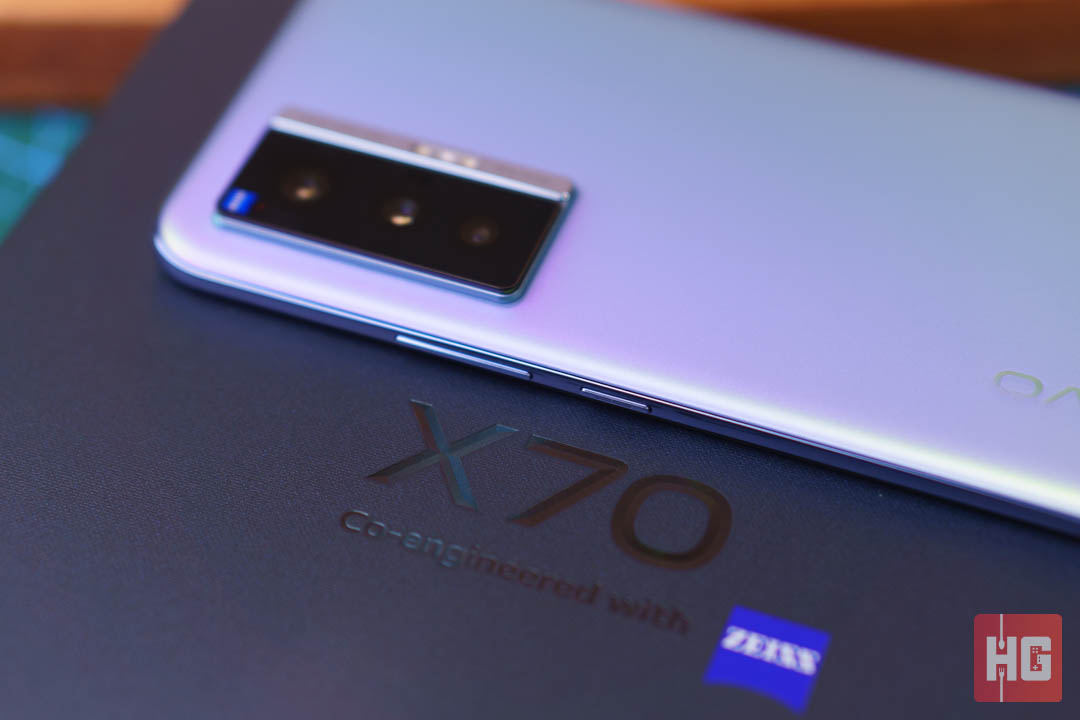
Its power button and volume rocker are all clustered at the right-hand side. They are positioned just right where your thumb can easily reach them without effort. All three buttons offer good tactility and does not have any wiggle.
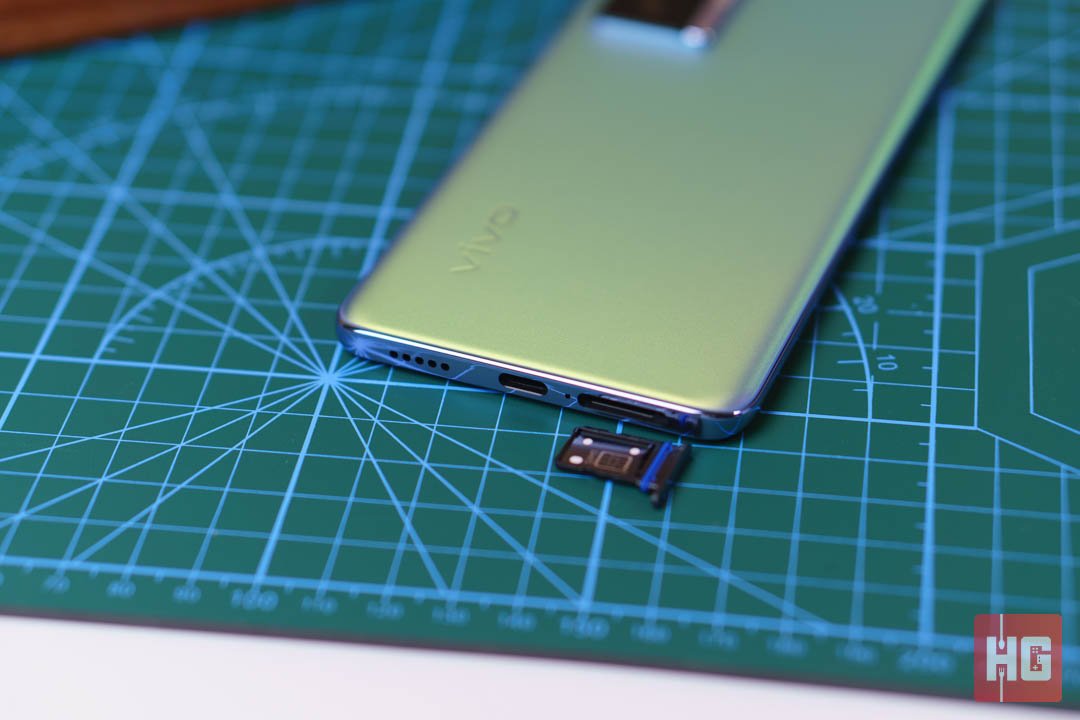
At the bottom are its bottom-firing speaker, USB Type-C port, and SIM Card tray. The tray only supports two NanoSIM cards and lacks a slot for storage expansion. There is no 3.5mm audio jack which relegates users to USB-C headphones or adapters.
Everything about the X70 feels rather standard for a vivo X series smartphone. It is rather disappointing, however, that the smartphone still lacks an IP rating for water and dust resistance. This is a missed feature especially for device positioned in the higher-end of the market.
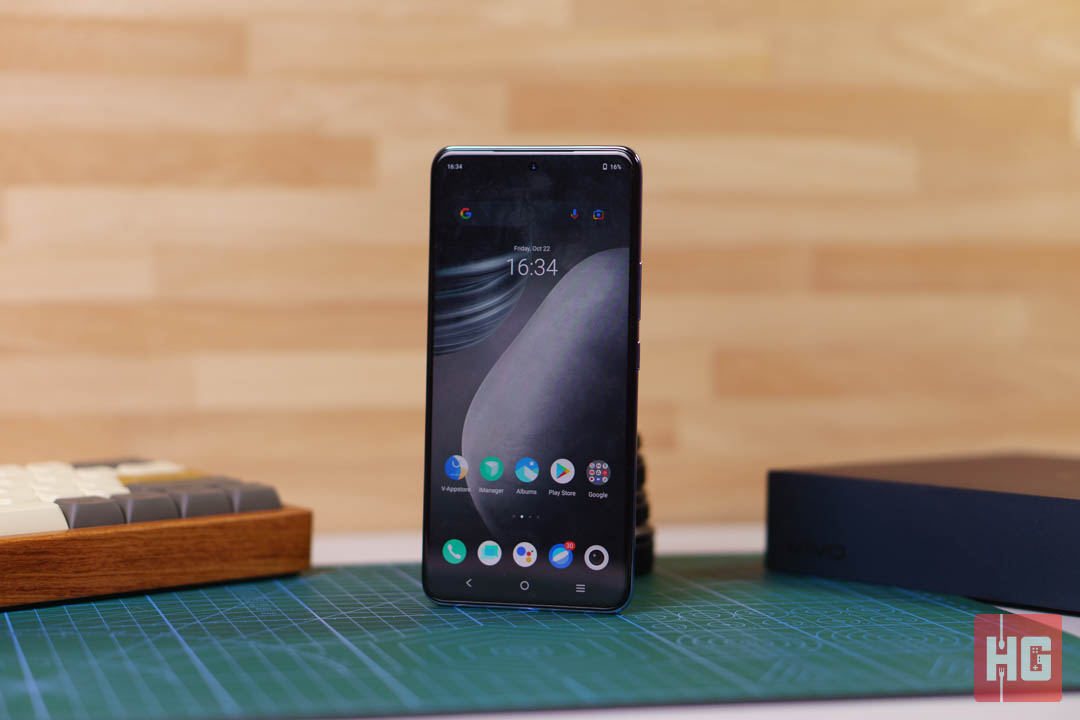
The vivo X70’s display comes with the same specifications as its predecessor: a 6.56-inch FullHD+ AMOLED screen running at 120Hz refresh rate with support for HDR10+. Its performance is pretty much what you expect from an AMOLED display: great colors, deep blacks, and wide color gamut. The 120HZ refresh rate also helps to provide more fluid animation in general use and in games that support higher refresh rates.
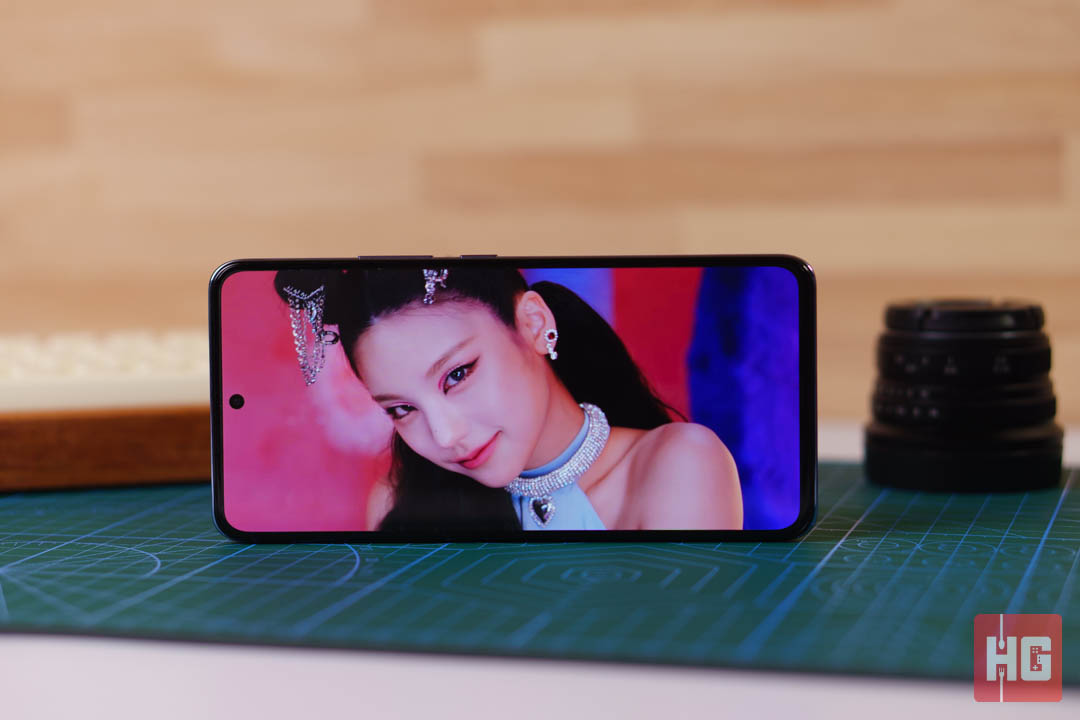
The X70 lacks stereo speakers and comes with only a single bottom-firing speaker. It does get loud, but it lacks the depth and soundstage that proper stereo speakers offer. Fortunately, there’s minimal distortion from the speakers even when turned to the maximum volume.
The global variant of the X70 ships with Android 11 with FunTouch OS 12 compared to its Chinese counterpart which has OriginOS 1.0. It adds several new features on vivo smartphones more colorful Always-On Display for AMOLED smartphones, and additional customization options.
It is worth mentioning that in addition to its 12GB RAM, the vivo X70 supports 4GB extended RAM. It uses part of its UFS 3.1 storage as additional memory if needed but it will be significantly slower compared to its actual RAM. We don’t expect, however, that many users will be able to max out its already capacious RAM.

The cameras are the main highlight of the vivo X70. At the back is only a triple camera but they have been co-engineered with Zeiss, who is famous for their lenses and optics. The smartphone sports a 40MP f/1.8 main lens with an IMX-776V sensor, a 12MP f/2.2 ultrawide, and a 12MP f/2.2 telephoto. They come with Zeiss T* Coating to improve lens quality by reducing anti-reflective properties and creates a surface more resistant to dirt.
The X70’s 40MP f/1.8 main lens can definitely capture stunning images regardless of condition. Colors pop but are unaggressive, details are preserved on darker areas, and there is proper dynamic range on high contrast scenes.
Video performance has also improved thanks to its ultra-sensing gimbal camera and VIS 5-Axis Ultra Stable Video. They make a lot of difference in handheld videos since they minimize frame crop and greatly stabilizes the video.
Its 12MP f/2.2 ultrawide has similar performance as the main lens. It does lose out on some detail due the lower pixel count but colors are still great and dynamic range is good. There is proper correction on the images and there is minimal fish-eye effect or distortion at the side.

The ultrawide camera also doubles as a macro lens since the X70 doesn’t have a dedicated unit. Camera quality is the same but slightly cropped. You can get pretty close to subjects and capture a good amount of detail but not close enough as some dedicated macro shooters.

The X70 has a 32MP f/2.45 selfie camera at the front. Again, images taken with this camera has superb colors and details. Leaving it on auto, however, will produce highly beautified photos with smooth skin and little skin detail. We suggest turning down the beautification.

Bokeh mode is available in varying strengths. People with short hair and minimal accessories will experience better background-subject separation but those with long hair will see artifacts at the sides.
A MediaTek Dimensity 1200 chipset powers the vivo X70 and its largely positioned against the Snapdragon 870 though it loses out on clock speed on its big cores compared to the latter. It still offers good performance across the board allowing for decent scores in synthetic benchmarks like AnTuTu, PCMark, and GeekBench.

Gaming is a breeze on the X70. It is unfortunate, however, that only a few mainstream games support its 120Hz display. None of our games in regular rotation supports the high refresh rate of the smartphone but it still delivers a smooth gaming experience across the board.
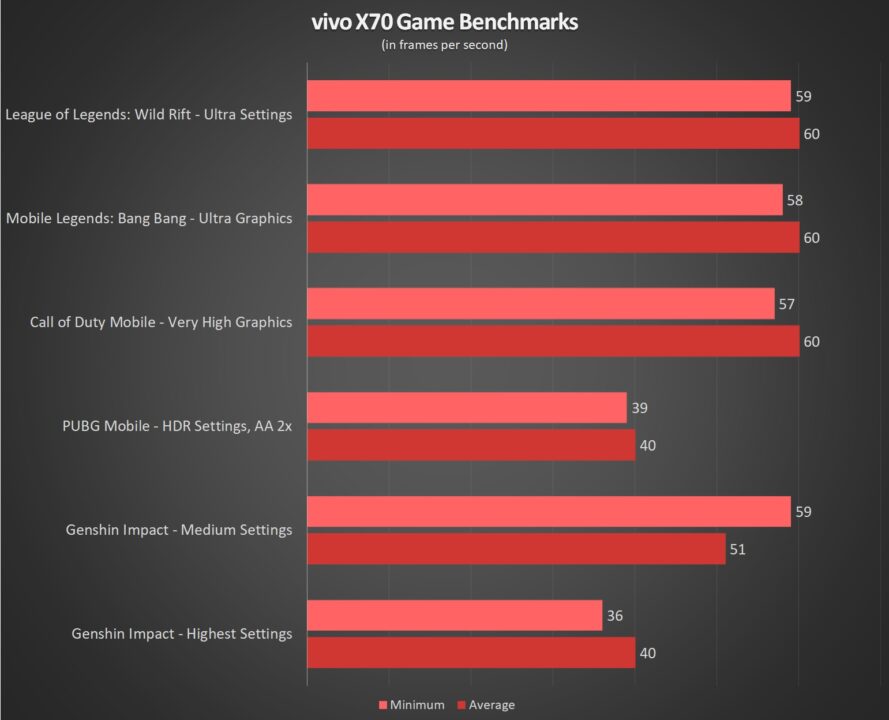
Based on our benchmarks, the X70 can deliver a steady 60fps on most titles. Genshin Impact remains one of the most graphically-intensive games in the app store but the smartphone can still get a solid 40fps in most scenarios.
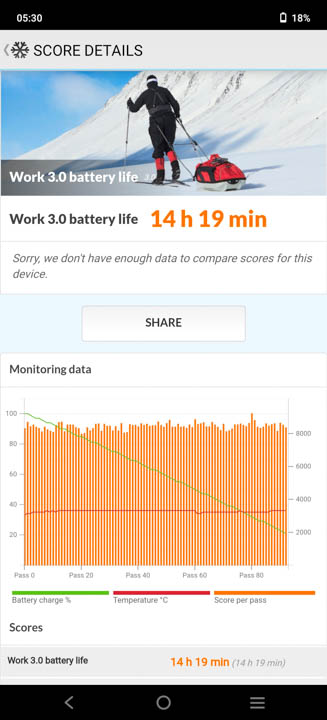
The smartphone gets its juice from a 4,400mAh battery. It isn’t the biggest in the market, but it can stretch usage to more than a day in just one charge. Running a PCMark Work 2.0 battery test nets it just above 14 hours of usage in medium brightness and volume.

Its USB Type-C port supports 44W Flash Charge. Again, not the fastest among its peers though it can top up its battery in around 1 hour and 20 minutes from completely empty to full.

The vivo X70 has a lot going for it for PhP 34,999. It has a flagship-class imaging system thanks to its partnership with Zeiss, which is able to capture professional-looking images with just a smartphone. Video has also been addressed with the addition of its gimbal system.
Performance of its MediaTek Dimensity 1200, while not on par on some of the higher-end flagships, is still decent in gaming and in general use. Its AMOLED screen is also able to produce deep blacks and good colors which enables you to enjoy viewing images and videos even more.
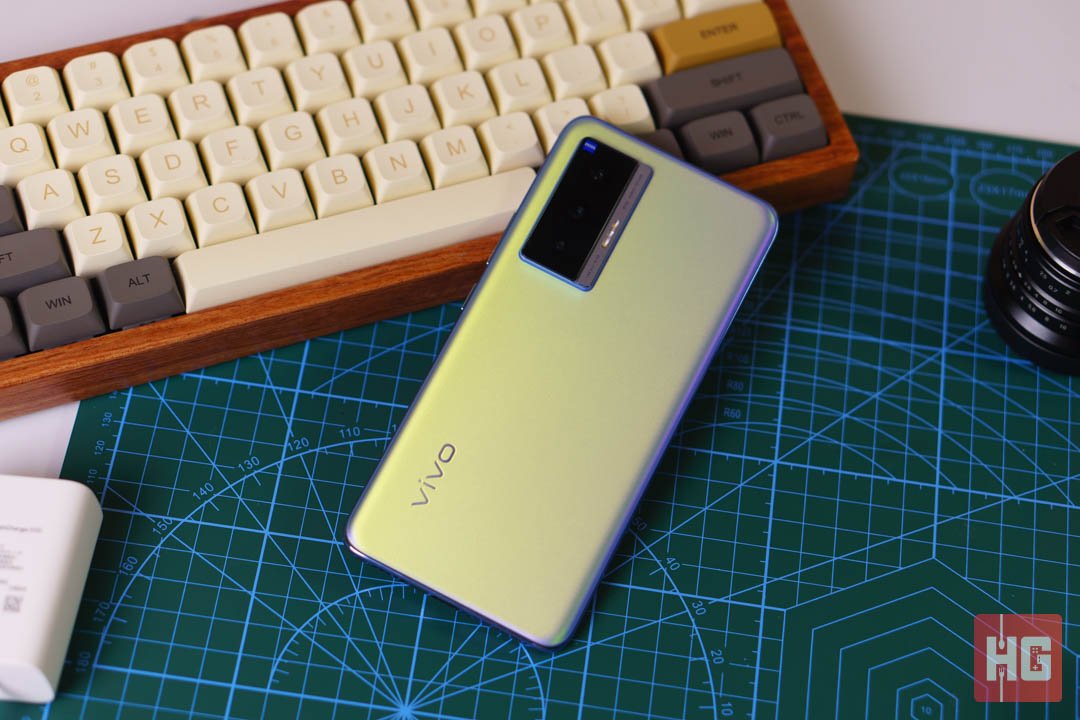
Some of the lower points of the device is its battery life and charging speed. We expected a premium device to last slightly longer than it can now and charging speed to be faster to its predecessors. Some may also dislike its two-tone design since even some midrange devices sport the look.

Overall, the vivo X70 is a solid device for the premium market. Its cameras deservedly take center-stage as they can deliver awesome-looking images and videos regardless of shooting conditions, which is why we are giving it our seal of approval.

The vivo X70 is now available in the Philippines for PhP 34,999 and will come in two variants: Cosmic Black and Aurora Dawn. You can get it through vivo stores and kiosks nationwide or via their official Lazada and Shopee online stores.
